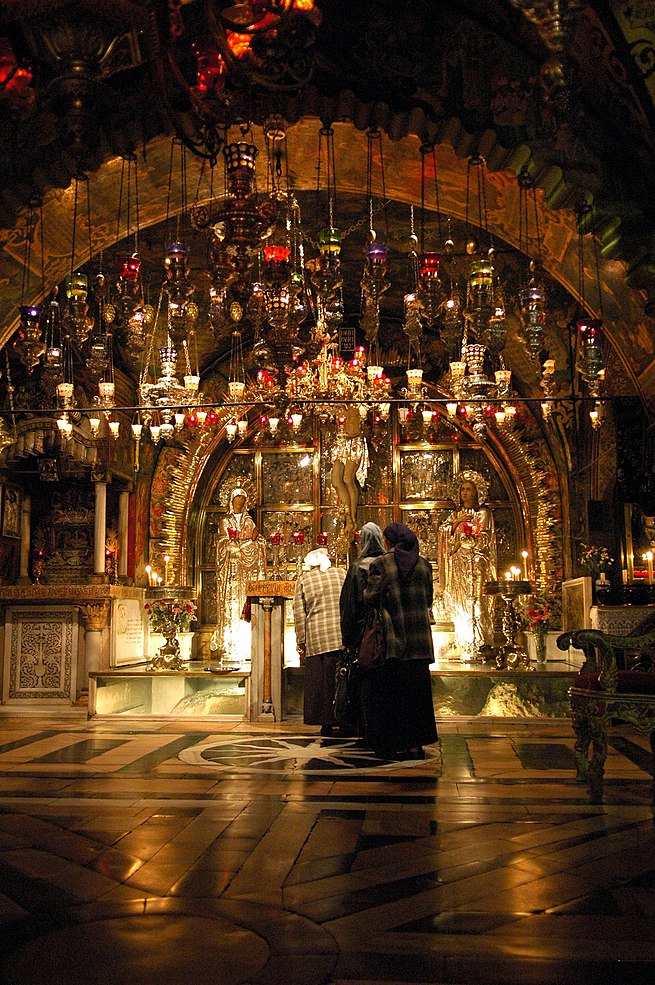
Main Difference
The main difference between Calvary and Cavalry is that the Calvary is a geographic location and Cavalry is a soldiers or warriors fighting from horseback.
-
Calvary
Calvary, or Golgotha (Biblical Greek Γολγοθᾶ[ς] Golgotha[s], traditionally interpreted as reflecting Syriac (Aramaic) golgolta, as it were Hebrew gulgōleṯ (גולגולת), “skull”), was, according to the Gospels, a site immediately outside Jerusalem’s walls where Jesus was crucified.Matthew’s and Mark’s gospels translate the term to mean “place of [the] skull” (Κρανίου Τόπος Kraníou Tópos), in Latin rendered Calvariæ Locus, from which the English word Calvary derives.
Its traditional site, identified by Helena of Constantinople, the mother of Constantine I, in 325, is at the site of the Church of the Holy Sepulchre. A 19th-century suggestion places it at the site now known as Skull Hill, some 500 m to the north (200 m north of Damascus Gate). Historian Joan Taylor bases a location c. 175 metres south-southeast of the traditional site on her reading of textual evidence.
-
Cavalry
Cavalry (from the French cavalerie, cf. cheval ‘horse’) or horsemen are soldiers or warriors who fight mounted on horseback. Cavalry were historically the most mobile of the combat arms. An individual soldier in the cavalry is known by a number of designations such as cavalryman, horseman, dragoon, or trooper. The designation of cavalry was not usually given to any military forces that used other animals, such as camels, mules or elephants. Infantry who moved on horseback, but dismounted to fight on foot, were known in the 17th and early 18th centuries as dragoons, a class of mounted infantry which later evolved into cavalry proper while retaining their historic title.
Cavalry had the advantage of improved mobility, and a man fighting from horseback also had the advantages of greater height, speed, and inertial mass over an opponent on foot. Another element of horse mounted warfare is the psychological impact a mounted soldier can inflict on an opponent.
The speed, mobility and shock value of the cavalry was greatly appreciated and exploited in armed forces in the Ancient and Middle Ages; some forces were mostly cavalry, particularly in nomadic societies of Asia, notably the Mongol armies. In Europe cavalry became increasingly armoured (heavy), and eventually became known for the mounted knights. During the 17th century cavalry in Europe lost most of its armor, ineffective against the muskets and cannon which were coming into use, and by the mid-19th century armor had mainly fallen into disuse, although some regiments retained a small thickened cuirass that offered protection against lances and sabres and some protection against shot.
In the period between the World Wars, many cavalry units were converted into motorized infantry and mechanized infantry units, or reformed as tank troops. However, some cavalry still served during World War II, notably in the Red Army, the Mongolian People’s Army, the Royal Italian Army, the Romanian Army, the Polish Land Forces, and light reconnaissance units within the Waffen SS. Most cavalry units that are horse-mounted in modern armies serve in purely ceremonial roles, or as mounted infantry in difficult terrain such as mountains or heavily forested areas. Modern usage of the term generally refers to units performing the role of reconnaissance, surveillance, and target acquisition (RSTA).
-
Calvary (noun)
A life-size representation of the crucifixion of Jesus Christ on a piece of raised ground.
-
Calvary (noun)
A series of representations of Christ’s Passion in a church.
-
Calvary (noun)
A strenuous experience.
-
Cavalry (noun)
The military arm of service that fights while riding horses.
-
Cavalry (noun)
An individual unit of the cavalry arm of service.
-
Cavalry (noun)
The branch of the military transported by fast light vehicles, also known as mechanized cavalry.
-
Calvary (noun)
the hill outside Jerusalem on which Christ was crucified.
-
Calvary (noun)
a sculpture or picture representing the scene of the Crucifixion.
-
Cavalry (noun)
(in the past) soldiers who fought on horseback
“the cavalry charged up the hill”
“the army numbered around 100,000 cavalry”
-
Cavalry (noun)
modern soldiers who fight in armoured vehicles
“a cavalry regiment”
-
Cavalry (noun)
used to refer to a source of help or rescue in an emergency, especially as a last resort
“she said she wouldn’t be sending in the cavalry to sort out the country’s problems”
